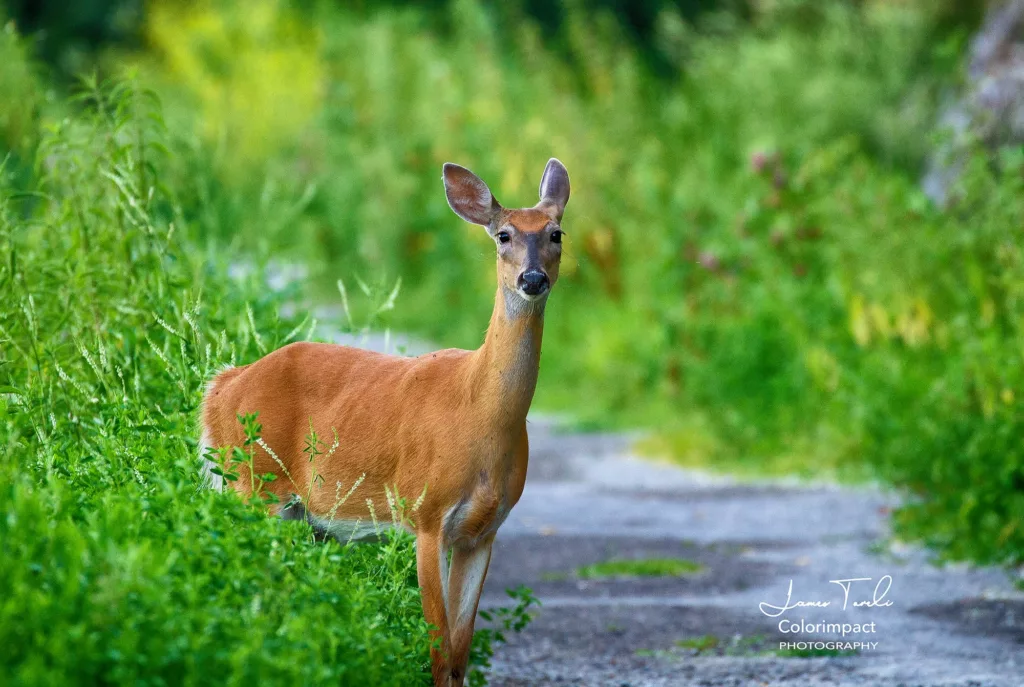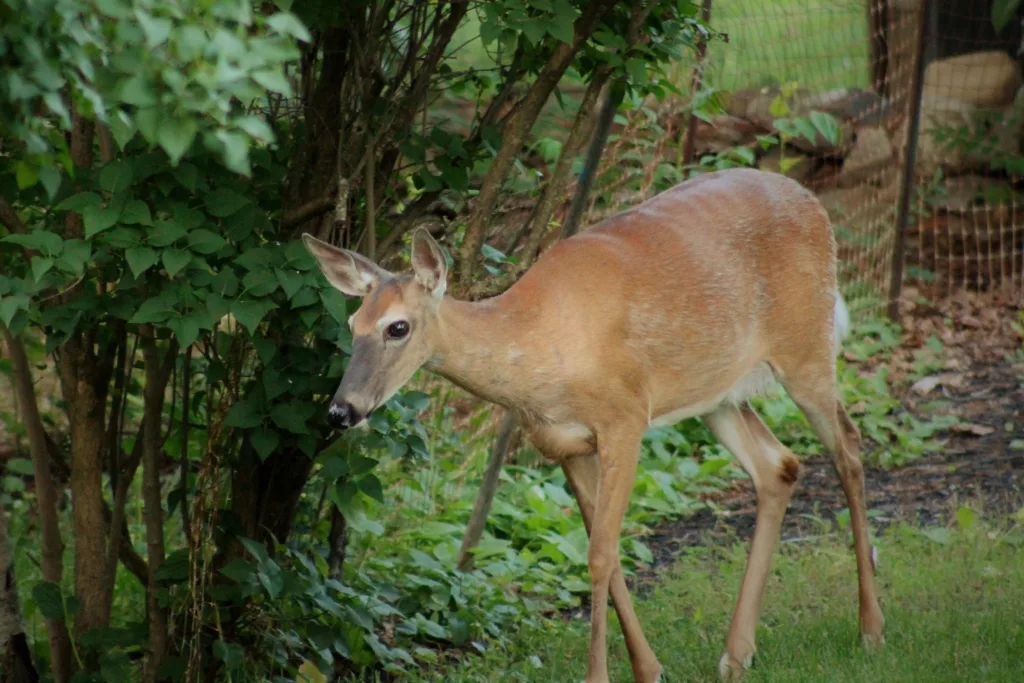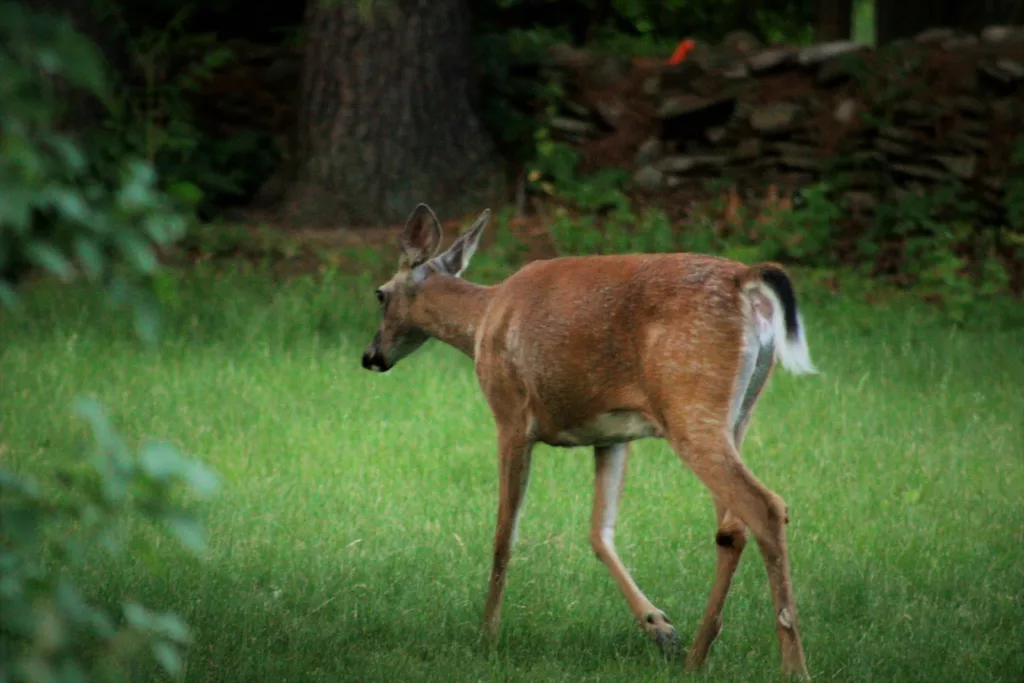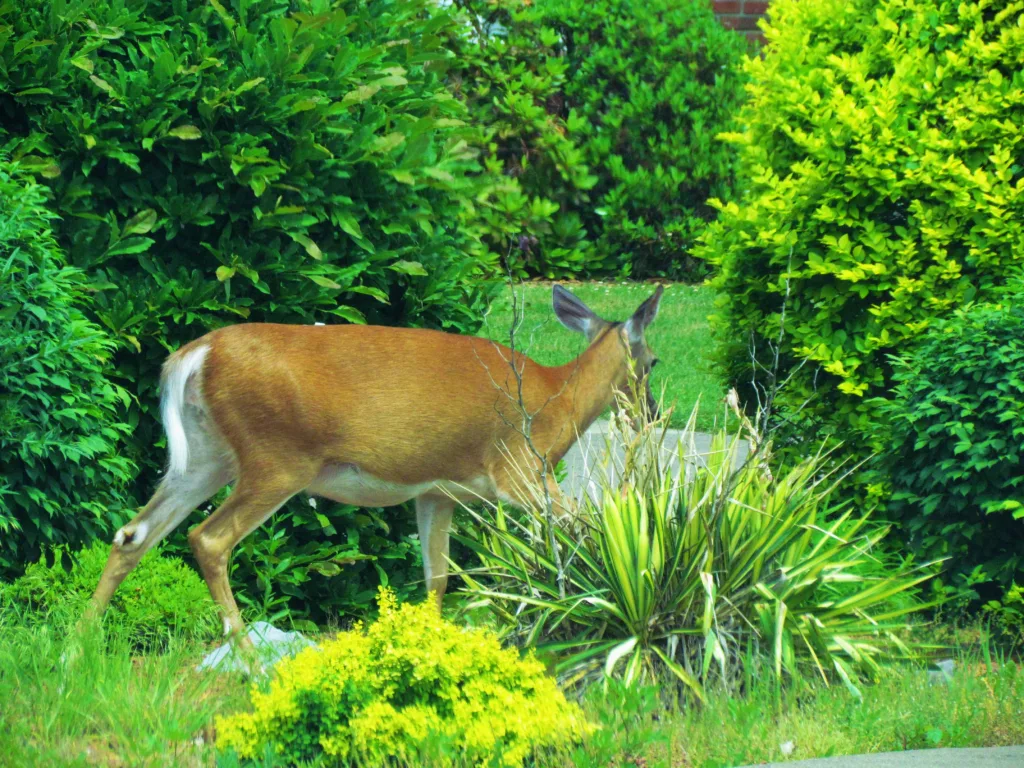This post may contain affiliate links. If you use these links to buy something we may earn a commission. Thanks.
Making noise to startle and scare deer away, or even prevent them from coming too close, is easy, but it’s a lot of work to maintain sound effectively unless you implement a schedule.
The wind or motion sensors can be used to automate plenty of deer-deterring noises while you aren’t spending time outside making natural commotion yourself.
Noise deterrents can be used to protect a garden from deer even without a fence.
In this post, I’ll cover all the best sounds to scare deer away and how you can make effective noise while you are away from the garden.
To keep deer second-guessing their approach, read the section at the end of this post on how to scare deer away with noise long-term after the list of noises.

Order deer-resistant:
Or, grow something easy that the deer are a lot less likely to eat; mushrooms! See: Grow a Mushroom Garden at Home in 4 Steps. While many say that deer eat mushrooms, others say the opposite, that their mushrooms have remained untouched. Deer haven’t eaten our mushrooms, so far, and we have a lot of deer frequently visit. So, it’s at least worth a try. And most mushrooms grow quickly enough that you’ll likely be able to harvest before they find it.
What noise scares deer away?
Particular noises indicate to a deer that something is out there, and it’s their shy nature to keep their distance from the commotion, as running away is their survival strategy.
The outdoors offers a constant ambiance of noise, so not every noise will scare deer—only certain types.
The sound of humans, activity, wind objects, wild or domesticated animals, ultrasonic frequencies, and alarms all scare deer away or prevent them from coming close. Sudden and loud noise causes them to leave the garden, and irregular automated commotion can keep them away from your area in general.
Unfamiliar noises will work to keep deer away for good. Use as many tactics as possible and rotate them for lasting effects. Don’t use any single noise tactic for too long… Continue
If deer make it into your yard, the goal would be to startle and teach them your place doesn’t offer rest and rejuvenation.
This can be done with a motion-sensing sound option.
Over time, deer become wearier in your space, especially when combined with sights of motion, smell, or both.
As they distance themselves, you’ll want to set up a timed interval of various noises, particularly around dawn and dusk.
Plenty of sound options are available with simple setups.
Each sound is best paired with another sensory strategy; I’ll provide ideas for each one. Below this list, we’ll talk more about deterring deer with noise long term.
1. Wind chimes that keep deer away
“Because deer are so skittish, adding wind chimes or even the static from a radio can be enough to scare them away. Anything unfamiliar will throw them off and make them too nervous to come any closer. Adding plants that deer dislike can keep them from exploring other areas of your yard.Jul 13, 2018″
Wind chimes may seem like a bogus way to deter deer from eating your garden. What makes them bogus is hanging them up where you want them, and leaving them for eternity.
If you want wind chimes for the purpose of scaring away deer, you’ll need to take them down more often than you have them hanging up.
Wind chimes scare deer away from an area as a new, irregular, and unfamiliar sound. Hang the chimes for a week or two as a deer deterrent. After that time, take them down and use them sparingly in a cycle of different deterring sounds.
You can also train deer to associate the chimes with your active presence by hanging them up every time you’re outside.
Take them down while you’re not around, and eventually, you can hang the chimes while you’re gone or indoors, and they’ll remain effective for short periods, as long as you don’t overuse them.
As a new sound, chimes work well at scaring deer and preventing them from investigating your garden because the wind is irregular.
Deer look to expand their food sources and with that, they’ll investigate areas that aren’t associated with a predator or human danger.
Deer will distance themselves from a new sound for a while until it becomes familiar or regular enough that is worthy of investigation.
Irregular sounds are key to deterring deer as patterns are easily recognized.
Lastly, switching the type of chimes can help keep their effect “fresh.”
What types of chimes scare deer?
A mix of different-sounding chimes on a randomized schedule, such as:
- stone chimes (my favorite sounding chime)
- stainless steel chimes (these sound good to us but like a human clanging about at work to deer)
- wood chimes (their deeper tone switches things up)
- DIY cutlery chime made with various utensils and sizes
- A rack of 2-3 pots and pans with a large metal spoon clanging by the wind is also an effective chime worth considering

2. Hanging tin pie pans
Pie pans function very similarly to wind chimes.
They also work by creating a sense of motion. As they move around in the wind, they have a larger surface area that is easily seen and reflect light that can look like movement.
Pie pans are a cheap way to change up your wind chimes if you only have one set.
We used pie pans and they worked for a couple of weeks until I didn’t ever take them down! At the time, I didn’t have anything else to put in their place.
So, I recommend you gather as many auditory options for your deer-deterrent “toolbox” as possible to ensure you don’t render any tactics ineffective by neglecting change.
3. The best ultrasonic deer repeller
Deer-repellent noise makers that don’t disturb you or the neighbors are ultrasonic devices.
You’ll miss out on multi-functioning benefits by choosing any plain ultrasonic device.
The best ultrasonic deer repellents are waterproof, solar-powered, motion-sensing, have flashing lights that look like eyes, and have good reviews. For deer, you’ll want a blue-white light rather than red and a 20-30 kHz ultrasonic wave.
This solar ultrasonic deer repeller, among many options, will do the best job as described above.
A waterproof device is important since it’ll need exposure to the sun to receive power.
The motion sensor ensures the sound is off while animals aren’t around. This makes the device a great backup if deer bypass or ignore your other deterrent efforts.
By that point, they may have decided to investigate your garden a little closer, will set off the ultrasonic sound and flashing lights, and learn that they made the wrong choice as a result.
Flashing lights can appear to be movement, as eyes in the dark could be a turning head or blinking eyes. The blue color is seen easily by deer both day and night, unlike red or orange.
Deer have a similar hearing range as we do, our range stops at 20 kHz while 30 kHz is still audible by deer. Until I learned that while researching an ultrasonic device for our garden, I was skeptical if they even worked.
4. Coyote sounds that make deer run
Coyote sounds scare deer away as they don’t want to take the risk of becoming their next meal.
A solar-powered speaker with sound recording capabilities, and motion-sensing, makes it easy to play coyote sounds that scare deer away from your garden.
This solar motion-sensing speaker is a very affordable option and you’ll be able to create and play any noise you wish.
Here are a few coyote-hunting sounds to rotate between:
If you play coyote sounds upon motion sensing, pair it with a coyote decoy for maximum scare effect (best for deer that wander too close into your garden).
Otherwise, keep deer at a distance by playing the sounds at timed intervals during dawn, dusk, or nighttime.

This article was originally published on foodforestliving.com. If it is now published on any other site, it was done without permission from the copyright owner.
5. Motion-detected radio sounds
Putting a radio outside is a popular tactic to keep deer away. Not permanent, like all others, but effective.
Radios keep deer out of your yard because it sounds like active humans outside. Dusk and dawn are the best times to play a radio outside near your garden or from a sheltered deck. Alternatively, record the sound of a radio on a motion-detecting speaker to startle the deer if they begin to approach.
I recommend incorporating radio sounds into your auditory deer deterrent routine because they serve more than one purpose.
A solar or hand crank charging outdoor radio is a multi-functional tool for any gardener, survivalist, outdoor explorer, and basic emergency kit.
This particular radio is very affordable and is capable of:
- emitting light with an LED torch flashlight
- providing direction with a compass reading
- receiving radio stations
- charging with solar power
- charging with a hand crank
- charging your phone with a USB cable
- emitting an SOS alarm sound and red SOS light signals
Of course, you can use any old radio you already have to deter deer.
For motion-detected radio sounds, rather than constantly playing a radio station, simply record the radio into the speaker mentioned in the coyote sounds section above.
Playing a live radio station is a great deterrent because it isn’t repetitive. But putting on a motion-detection option is a good way to change up your deterrent tactics to prevent the deer from getting used to it.
6. Natural sounds humans make
Being in the garden is an easy way to make a natural human commotion. The whole point of protecting a garden without a fence, though, involves excluding deer while you’re gone too.
The sound of yelling, talking, throat-clearing, coughing, sneezing, and running can keep deer away from the garden even if you aren’t around. Make prerecorded audio of some startling dialogue and put it on a motion sensor.
The effective element of this is you can change the dialogue in an infinite number of ways. As soon as the motion sensor sees the deer, it’ll set off the human noises and the deer will retreat back to the forest or search for a quieter area.
This option gives the “radio sounds” a break since it won’t have all the fuzz and music that a radio show does—a great and easy way to change it up which is essential for these strategies.
7. Human commotion of tools being used
If deer hear the same recording of you talking all the time, they may become comfortable and decide to investigate. To prevent that from happening, you can also record several sounds of general commotions when using tools so they think you’re actively working outside.
The sounds of screwing together metal frames, woodworking, chain-sawing, shoveling, or hammering are examples of human commotion that keep deer away. Play these sounds during dawn or dusk to keep deer away during their prime foraging time.
Human commotion is most effective when played for a while, on and off, and at random intervals.
8. Security alarms or sirens
Loud and sudden noises are excellent deer deterrents—it puts a knot in anyone’s stomach to be warned about trespassing.
Security alarms and sirens are best at startling deer away when set off by a motion sensor. Alarms are better at scaring deer off your property when they enter, rather than deterring them from coming near, to begin with.
Pair this with a sprinkler or other physical (non-harmful) consequence and it’ll reinforce the idea that they should stay away.
More insightful than a sprinkler, is a solar ring spotlight cam. An ability to view the behavior of deer while you’re gone will help you make informed decisions with your deterrents. To see what’s working, and adjust as needed to prevent tactic overuse.
Startling deer with loud noises on a motion sensor is a perfect backup if you do overuse any of the tactics that are meant to keep them from coming in close, to begin with.
If radios or recordings begin to show signs of failure, a startling motion sensor can teach them that they made the wrong choice of investigating your yard anyway.

9. Dog barking or a jingling collar
A barking dog is a warning for deer and an opportunity to avoid expending needless energy.
Deer will turn and head the other way when they hear a dog bark or a collar jingle as they would rather not be chased by a predator. These sounds can be recorded and played to deter deer from approaching and familiarizing themselves with your garden.
If a deer has ever been chased by a dog or a coyote, it knows how not fun running for its life is. Unfortunately, your dog isn’t likely to be outside 24/7 to keep watch.
Fortunately, you can use a motion-sensing dog barking device, however, I recommend the solar motion-sensing speaker so you have unlimited sound type options.
10. Percussion instruments: music or randomized
Percussion instruments are cheap and provide a variety of sound options.
Percussion instruments make pleasant sounds that can scare deer away from your yard. Incorporate 2-4 instruments, and even singing to deter deer from coming in closer.
If you’re the type to sit around a backyard campfire with friends, guitars, and a drum, consider adding in a tambourine, singing, and laughter.
Record a session or a single instrument, on the solar motion sensing speaker, and play it sometimes while you’re not outside before and into the dark.
Especially if you’ve played by the campfire for real, the deer will associate this will human activity and keep clear.
11. Sudden explosions or gunshots
Gunshots may not scare every deer, but sudden and loud noises are frightening for anyone.
I do not recommend playing a recording of gunshots or explosions, but rather keeping these sounds to a motion sensor. As they are so short-lived, playing them over and over will easily accustom deer to their sound rendering them ineffective.
Deer often associate real gunshots with the smell of burnt gunpowder if they are familiar with hunters. The goal of explosions and gunshot noises would be to startle the deer so they sense danger in your area and leave.
How to scare deer away with noise (long-term)

I’ve provided a long list of noise options so you can scare deer away long-term—the same noise won’t be effective at scaring deer away forever. Most tactics are short-lived as deer adapt and investigate if danger is not associated with a familiar sound.
How can sound be an effective deer deterrent long term?
Collect and implement a large variety of noises that can be played while you aren’t in the garden to deter deer from coming close. To reinforce your sound deterrents, set up short-lived but loud and startling noises on a motion sensor to teach deer they made the wrong choice by investigating.
Avoid playing sound 24/7 non-stop, or worse, using the same sound for weeks and never switching it to something else.
Deer are smart and adapt quickly. It won’t take them long to recognize a pattern, associate no danger with it, and begin exploring.
It isn’t the tactic itself that often fails, it’s the way tactics are implemented that fail.
Any tactics can quickly become recognized as a non-dangerous pattern if you overuse them.
Noise and sound are best used as a preventative to deter deer. If deer are already comfortable in your yard, you’ll need to associate consequences with noises and human presence.
Nonharmful consequences could include:
- a sudden startling using a motion-detected alarm (passive consequence)
- throwing small rocks at them when you see them (if they are comfortable around you, teach them that they should be uncomfortable, even at a distance from you) (active consequence)
- spraying their favorite plants with a spicy cayenne taste (passive consequence)
- setting up a chicken wire “spring” (passive consequence)
The chickenwire “spring” story… I had put chicken wire around our elderberry plant that they really love with the intention that they wouldn’t be able to physically chomp it back anymore.
The next day, the chicken wire was all mangled and off the stake. What had happened is, the deer attempted to get to the elderberry but instead, the chicken wire flung off the stake (because I didn’t secure it well) and the deer got caught up in the wire—an unpleasant experience.
Although the elderberry had then been exposed, the deer didn’t touch it because the wire was enough trouble to leave. No other plants had access attempts, and of all plants, I was lucky that they went for the unsecured wire to learn this lesson by experiencing a consequence for touching the wire!
Now, I have the opportunity to deter them using other means such as sounds, sights, tastes, and smells.
To rotate your noises and sounds, so they stay effective, it’s very important to:
- change it up all the time
- combine with other sensory disruptions
- not to skip any seasons, even winter
Create or follow this schedule to Keep Deer Out of The Garden Without A Fence.
Recent Posts
There’s no shortage of full-sun ground covers for zone 4 climates! Each plant in this list can withstand the frigid temperatures and also enjoy the hot sun in summer. Full sun means that a plant...
There's no shortage of full sun ground covers, not even in zone 3! Zone 3 climates offer hot but short-lived summers and very cold winters. So each plant in this list can withstand the frigid...
